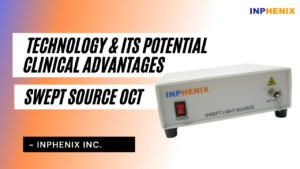
The 21st century witnessed a significant revolution in imaging techniques. The continuous innovation in this area has introduced us to many advanced technologies in the last two decades, which include TD-OCT (Time-Domain Optical Coherence Tomography), SD-OCT (Spectral-Domain Optical Coherence Tomography, and SS-OCT (Swept Source OCT) where Swept Source is a type of laser incorporated in the device.
The Swept Source OCT technology was first introduced to the clinical world around 2012, which had overshadowed its preceding technologies, namely Time-Domain OCT and Spectral-Domain OCT. The swept-source OCT has helped retina specialists and other surgeons to overcome the limitation of previous imaging technologies.

Let us understand the familiarity and similarity between Swept Source OCT and Spectral Domain OCT.
The SD-OCT and SS-OCT have some major differences in their design and hardware, including the bulk optics components, photodetection device, and light source.
For example, Swept Source OCT’s wavelength is centered at 1 µm approximately, whereas SD-OCT uses an 870-nm wavelength light source.
Similarly, the mechanisms of both of these modalities are quite different too. SD-OCT reflects different frequencies of light concurrently on the object and then separates the frequencies with the spectrometer’s help. In contrast, SS-OCT uses a laser that passes through different frequencies over a period of time.
SS-OCT has some quality advantages over its predecessor technologies, i.e., Time-Domain OCT and Spectral-Domain OCT such as,
SS-OCT has successfully established itself as one of the most innovative imaging technologies with substantial clinical impacts and acceptance in ophthalmology. Below are some of the critical applications of SS-OCT.
Using SS-OCT, we can get a detailed visualization of the posterior segment. The technology effectively identifies the progression of the pathologic process and monitors surgical or non-surgical intervention. Besides, it also works well for following the anatomic changes that can occur with macular disease treatment.
Swept Source OCT has manifested itself as the dominant visualization modality in detecting & managing glaucoma and retinal diseases. It obtains a high-resolution, clear image of ocular structures, including choroid and lamina cribrosa. The early detection of glaucoma with the help of SS-OCT will have a significant impact on the treatment.
Diabetic Retinopathy disease is found in patients with diabetes condition. The increased blood sugar level damages the blood vessels of the eye retina. If not medicated on time, this disease can damage your eyesight and steal your vision forever. Swept Source OCT can be beneficial in diagnosing and treating diabetic retinopathy by providing high-resolution cross-sectional images of the retina.
Inphenix is a US-based company that designs and manufactures lasers and light sources that have extensive demand in the telecom, sensing, medical, and measurement industries. Our Swept Source OCT possesses multiple salient features such as deep penetration, long coherence length, and high resolution. We offers Swept Sources in three different variants- 1060nm, 1310nm, and 1550nm windows, which are ideal for OEM integration.
